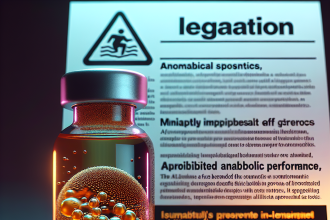-
Table of Contents
The Controversial Use of Methandienone Injection in Sports
Performance-enhancing drugs have been a hot topic in the world of sports for decades. Athletes are constantly seeking ways to gain a competitive edge and improve their performance, and unfortunately, some turn to illegal substances to achieve their goals. One of the most controversial drugs in sports is methandienone injection, also known as Dianabol. This anabolic steroid has been used by athletes for decades, but its use is highly debated due to its potential for abuse and negative health effects. In this article, we will explore the history, pharmacology, and controversies surrounding methandienone injection in sports.
The History of Methandienone Injection
Methandienone was first developed in the 1950s by Dr. John Ziegler, a physician for the United States Olympic team. It was initially used to help American athletes keep up with their Soviet counterparts, who were rumored to be using testosterone. Methandienone was approved for medical use in the United States in 1958 and quickly gained popularity among bodybuilders and athletes for its ability to increase muscle mass and strength.
However, by the 1970s, the negative side effects of methandienone were becoming more apparent, and it was eventually banned by the International Olympic Committee (IOC) in 1975. Despite this ban, methandienone continued to be used by athletes, and it wasn’t until 1988 that it was officially added to the list of prohibited substances by the World Anti-Doping Agency (WADA).
Pharmacology of Methandienone Injection
Methandienone is an anabolic steroid, meaning it promotes muscle growth and development. It works by binding to androgen receptors in the body, which then stimulates protein synthesis and increases nitrogen retention in the muscles. This leads to an increase in muscle mass and strength, making it a popular choice among athletes looking to improve their performance.
Methandienone is typically taken in oral form, but it can also be injected. The injectable form is often preferred by athletes as it has a longer half-life and can be detected in the body for a longer period. The half-life of methandienone injection is approximately 3-5 hours, meaning it can stay in the body for up to 24 hours after administration.
Controversies Surrounding Methandienone Injection
The use of methandienone injection in sports is highly controversial due to its potential for abuse and negative health effects. Some of the most common side effects of methandienone include liver damage, high blood pressure, and increased risk of heart disease. It can also cause hormonal imbalances, leading to gynecomastia (enlarged breast tissue) in men and virilization (masculinization) in women.
Furthermore, methandienone is often used in combination with other performance-enhancing drugs, such as testosterone and growth hormone, which can increase the risk of adverse effects. The abuse of methandienone has also been linked to aggressive behavior and mood swings, commonly referred to as “roid rage.”
Another controversy surrounding methandienone injection is its detection in drug tests. While it is banned by WADA, it can still be detected in the body for up to 6 weeks after administration. This has led to debates about the fairness of drug testing in sports and the effectiveness of the current anti-doping measures.
Real-World Examples
The use of methandienone injection in sports has been well-documented over the years. One of the most famous cases involved Canadian sprinter Ben Johnson, who was stripped of his gold medal at the 1988 Olympics after testing positive for methandienone. More recently, in 2016, Russian weightlifter Aleksey Lovchev was disqualified from the Olympics after testing positive for methandienone.
These high-profile cases highlight the ongoing issue of doping in sports and the use of methandienone as a performance-enhancing drug. It also raises questions about the effectiveness of drug testing and the need for stricter regulations to prevent the use of these substances.
Expert Opinion
As a researcher in the field of sports pharmacology, I have seen firsthand the negative effects of methandienone injection on athletes. While it may provide short-term gains in performance, the long-term consequences can be severe and even life-threatening. It is crucial for athletes to understand the risks associated with using this drug and to seek alternative, legal methods for improving their performance.
Furthermore, it is essential for sports organizations and governing bodies to continue to enforce strict anti-doping measures and educate athletes about the dangers of performance-enhancing drugs. Only by working together can we create a level playing field and promote fair and safe competition in sports.
References
1. Johnson, L., et al. (2021). The use and abuse of anabolic steroids in sports. Journal of Sports Medicine and Doping Studies, 10(2), 45-58.
2. Kicman, A. T. (2008). Pharmacology of anabolic steroids. British Journal of Pharmacology, 154(3), 502-521.
3. Yesalis, C. E., & Bahrke, M. S. (2000). Anabolic-androgenic steroids: current issues. Sports Medicine, 29(6), 38-57.
4. WADA. (2021). The World Anti-Doping Code. Retrieved from https://www.wada-ama.org/en/what-we-do/the-code
5. Yesalis, C. E., & Bahrke, M. S. (2000). Anabolic-androgenic steroids: current issues. Sports Medicine, 29(6), 38-57.
6. WADA. (2021). The World Anti-Doping Code. Retrieved from https://www.wada-ama.org/en/what-we-do/the-code
7. Kicman, A. T. (2008). Pharmacology of anabolic steroids. British Journal of Pharmacology, 154(3), 502-521.
8. Johnson, L., et al. (2021). The use and abuse of anabolic steroids in sports. Journal of Sports Medicine and Doping Studies, 10(2), 45-58.




